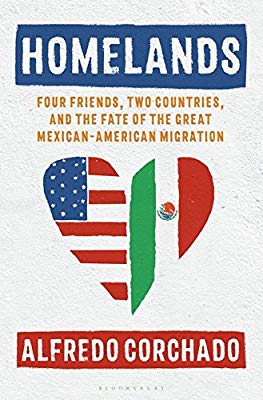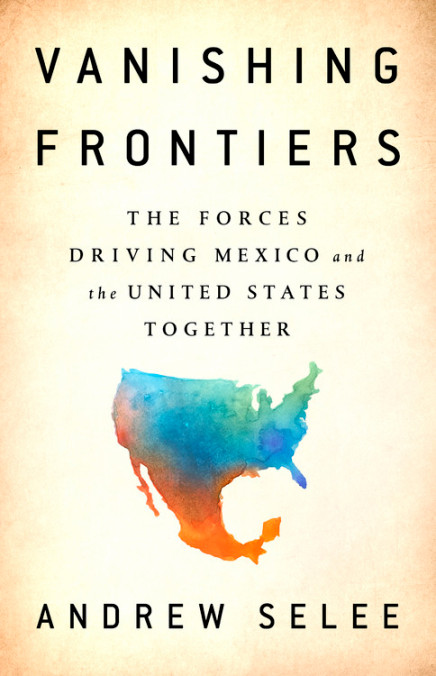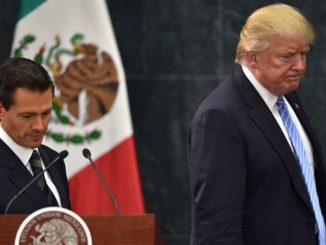
Two timely new books offer a needed antidote to the president’s anti-Mexico rhetoric.
The United States and Mexico are more culturally and economically intertwined now than at any point in their histories – even with President Donald Trump clinging to his promise to build an “impenetrable” border wall and make Mexico pay for it.
Two timely new books about this deepening bilateral relationship offer an explicit rebuttal to the recent revival of anti-Mexico rhetoric. Alfredo Corchado’s Homelands: Four Friends, Two Countries, and the Fate of the Great Mexican-American Migration brings the dramas of immigration to life with a touching autobiographical tale, while Andrew Selee offers expert analysis in Vanishing Frontiers: The Forces Driving Mexico and the United States Together.
In the former, Corchado, an award-winning journalist who left Mexico with his family as a child, offers a fascinating account of his own immigration story and the enduring bond he formed with three friends over tequila shots in a Philadelphia restaurant.

The book makes clear that the current wave of U.S. nativism is no bolt from the blue.
Corchado highlights some precursors to Trump, including Samuel P. Huntington, a political scientist who argued that Mexican immigration would trigger a “clash of civilizations,” and Pat Buchanan, a Republican presidential nominee who promised to construct his “Buchanan fence” along the southern border.
The book also casts a critical eye at the high number of deportations under the last two Democratic presidents, Barack Obama and Bill Clinton.
Throughout, Corchado invests his narrative with a rich variety of voices. For many, the old humiliations of the Mexican-American War still loom large. The war was brought to an end with the 1848 Treaty of Guadalupe Hidalgo – beginning a process in which Mexico lost more than half of its territory to its northern neighbor.
“How can any Mexican trust the United States?” Corchado’s mother asks. “Americans might wake up and decide to deport everyone, or take another chunk of Mexico.”
Yet the book also shows how, despite those misgivings, the United States came to occupy an important place in the collective imagination of many Mexicans.
Corchado reflects on the experience of Jovita, the mother of a close friend, who grows so tired of hearing migration stories in her hometown that she travels north so she can share in their experience. “Ironically, Jovita felt that leaving, embarking on the same journey as so many of her neighbors, would be the only way to feel at home.”
Homelands further shines a light on the way immigration reform in the mid-1980s disrupted seasonal migration cycles from Mexico. Tightened border security inadvertently kept many Mexican immigrants in the country, rather than allowing them to leave.
“Another Mexico was growing in the United States,” Corchado writes. “The other Mexico was trapped, on the cusp of the unknown.”
The four friends at the center of Corchado’s moving tale take on the symbolic weight of the entire Mexican diaspora, while the border fence becomes nothing more than “America’s latest gasp of resistance to its own immigrant story.”

Vanishing Frontiers similarly explores U.S.-Mexico integration, focusing on issues such as migration, trade and security.
Selee, the president of the Migration Policy Institute, contends that Trump’s presidential campaign was largely run on misconceptions about the bilateral relationship. Mexico, he writes, has become “a proxy for all debate about immigration,” even though since 2009 more Mexicans have left the United States than have arrived.
While Trump’s animosity toward Mexico appeals to a segment of the U.S. population, Selee explains that, by most metrics, the two countries are closer partners today than at any time in history.
To start, the North American Free Trade Agreement (NAFTA) has fueled economic growth on both sides of the border. Mexico has become the second-largest buyer of U.S. exports after Canada, and industries such as auto and aerospace have become integrated across North America.
While Selee concedes that some manufacturing jobs have moved south, he underlines the far greater impact of automation on employment. He also contends that NAFTA has created many – and perhaps more – U.S. jobs than have been lost, by bolstering the competitiveness of U.S. industries.
In Mexico, NAFTA has fueled long-term economic growth and contributed to an expansion of the middle class, a rise in education levels, and an increase in life expectancy, Selee writes.
The book looks favorably on the prospect of deeper integration, even when it comes to the drug war, where Selee highlights U.S. efforts to strengthen the rule of law in Mexico and growing levels of cooperation among security agencies on both sides of the border.
Vanishing Frontiers does not, however, explore the link between U.S. drug policy and its contribution to organized crime in Mexico. Nor does it consider NAFTA’s impact on drug and arms trafficking. Dealing with these issues could have provided a worthwhile counterpoint to the book’s prevailing argument.
Nevertheless, Selee offers a timely antidote to Trump’s dark vision of the bilateral relationship. Like Corchado, he shows how deepening integration has expanded beyond economics, as lasting individual and cultural relationships have formed across the border.
As the author writes: “The frontiers that once separated us will continue to vanish as forces stronger and more dynamic than any presidential order or trade agreement continue to bring us closer together.”



